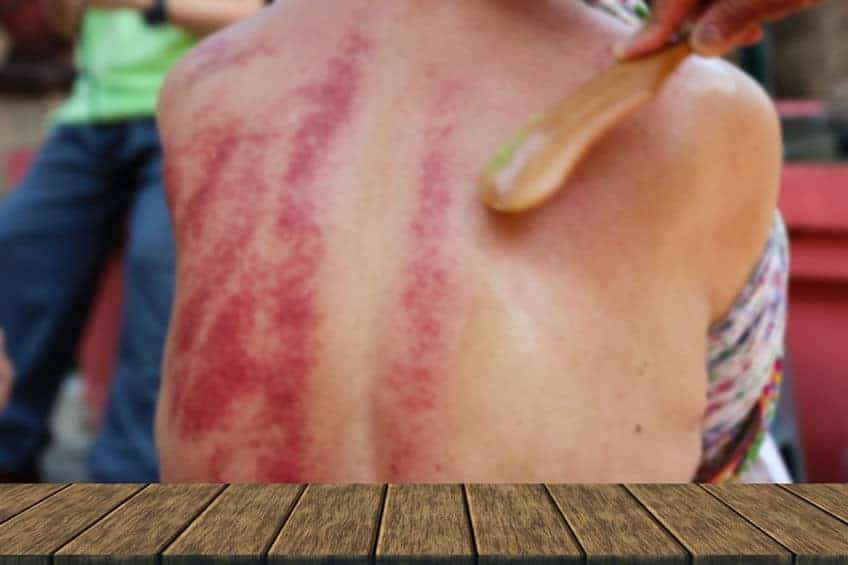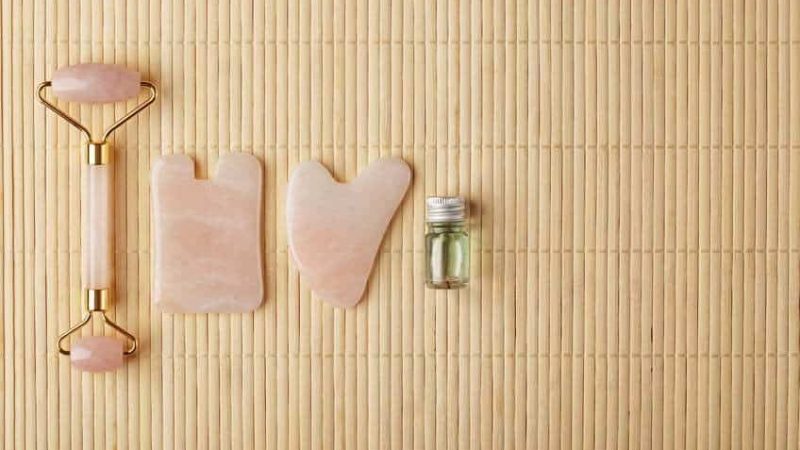FUN FACT: Did you know that your skin accounts for about 15% of your body weight?
What is Gua Sha Massage?
This is a Chinese word that is pronounced as Gwah-Shah is defined in two parts — “Gua” means “scrape” while ‘Sha’ is said to mean “sand” by some people, while others seem to give it “redness of skin”. We could say it is a method of scraping away disease, fever or some type of sickness from the body generally. However, other words for the term “Gua Sha” are skin scraping, spooning, coining.
It is a healing procedure copied from traditional East Asian medicine. It used to be a natural traditional therapy that involves using a “spatula” made from buffalo horn to massage the skin.
The Gua Sha tool has been adjusted and modernized and made from finer materials such as jade or rose quartz to massage the appropriately lubricated area of the body surface in upward strokes, or in a swift and gentle but vigorous scraping motion in order to relax stiff muscles while relieving pain and tension, treat certain illnesses, as well as improve blood circulation.
It creates minor bruises which either appear as purple or red marks known as “Petechiae” or “sha”.
Gua Sha has been used by a good number of Holistic category finalists in The Skin Games as part of their treatment modality. I see on social media that this treatment has already become extremely popular and I assume that promotional campaigns run by companies such as The Marketing Heaven stand behind it.
History of Gua Sha
GuaSha Massage has been widely used by the ancient Chinese for a really long while now as a folk therapy. In the Ming Dynasty between 1368 and 1644, the procedure was scientifically computed into major medical records. Although, the period of the practice of Gua Sha is assumed to be much older, its first computed record dates back to about 700 years ago during the era of the Ming Dynasty.
Historical records on GuaSha date back to the Paleolithic Age. When people fell ill or entered a coma, hands or stones, as well as household materials such as coins or tins, were used to massage parts of their bodies to help reduce the side effects and symptoms of their illnesses.
Gua Sha Techniques
Gua Sha techniques are an integral part of the Traditional Chinese Medicine (TCM) tool kit, with each technique serving a specific purpose. Among these techniques is the GuaSha Massage technique, which is utilized to unblock and restore the flow of Qi in the targeted area, promoting overall well-being.
Basic Technique to Gua Sha:
- Apply a reasonable amount of thick lubricant or oil to the skin.
- Make sure your upper body is fine and calm.
- Hold the Gua Sha instrument firmly and properly in your hand at a 30-45 degree angle towards the area you are about to scrape.
- Begin to scrape in one direction – down, away from the head, or sideways, away from the spine.
- Scrape the first few strokes for some time before applying a little more pressure.
- Maintain consistent pressure. Don’t go too hard, or too soft.
- Apply long and continuous strokes between 15cm – 20 cm or 6 – 7 inches.
- Be consistent with scraping in just one direction Don’t injure your client by changing directions while scraping on a particular area of the skin.
- Each stroke should be applied about 10 to 30 times before proceeding to the next area.
- Spend a little more time on an area that has more sha, and move to the next skin area when there is no more she.
- Cover treated areas immediately with a towel to keep it warm.
General Technique to GuaSha Massage:
This technique can be applied on the fine muscles of the head and face but with tender strokes. However, it is generally advised that you use a fine tool that can easily get into the angles and follow the outlines of the skin area to be treated.
- Carefully scrape and lift the skin from the forehead up, towards the hairline using the smooth edges of the right tool. At that point, you move to the side of the nose and the facial structure and scratch outward and up towards the ears and afterward scratch downwards on the face sides.
- Proceed along these lines until you’ve covered all the painful parts and blocked areas that need to be treated. The lucky person who receives this treatment is likely to experience immediate pain relief, feel lighter, and a nearly “unplugged” sensation as though the skin has been unblocked somewhere inside.
- After the Gua Sha session, you can give your ‘client’ a “room temperature” (not iced) glass of water in order to avoid unhealthy effect on the internal organs.
- Allow your client to rest for some time cause the body must have gone through a lot during the procedure though it may not seem like it.
- Your client should not be allowed to shower or bathe directly, for about an hour or more after treatment.
- They should avoid direct breeze of air and should be wrapped to keep warm instead.
Benefits of Gua Sha
- Improves the movement of lymphatic fluids and breaks down tension in muscles and knots in the face, neck, and shoulders.
- Reduces facial lines, and can be used almost like a gentle, natural face-lift which results in less puffy eyes and sharper cheekbones.
- Increases blood circulation while lifting and firming the skin.
- Gives the face a smoother complexion and more sculpted features.
- Reduces hyperpigmentation on the treated surface area of the skin.
- Because it may decrease inflammation on the skin, it is frequently used to treat sicknesses that cause chronic pains like arthritis and fibromyalgia, as well as those that trigger muscle and joint pains.
- Relieves the side effects of conditions such as Migraine headaches, Neck pain, Perimenopausal syndrome, Hepatitis B, Breast engorgement, Tourette syndrome, etc.

Side Effects of Gua Sha
- It usually leaves red or purple bruises on the skin.
- The tiny blood vessels near the surface of the skin called capillaries may burst.
- Although Gua Sha treatment is not supposed to be painful, it however deliberately causes bruises, which may be discomforting for some people.
- There is a risk of getting a broken skin during the procedure which may cause infection and of transferring blood-borne diseases if bleeding occurs. This is why Gua Sha practitioners should always sterilize their tools between treatments.
- Some people may experience temporary skin indentation after a Gua Sha treatment.
It is important to note that Gua Sha bruises usually take a few days or a week to heal and can be tender while healing. People can take an over-the-counter painkiller, like ibuprofen to kill pain and reduce swelling.
Clients should be advised to protect the bruised area, and be careful not to bump it. Applying an ice pack on the bruised area can help to reduce inflammation and ease any pain.
GuaSha is not a procedure suitable for everybody and it may cause more harm than good for those who should not go through the procedure which includes but is not restricted to the following people:
- had surgery in the last six weeks.
- with medical conditions affecting the skin or veins.
- have an infection, tumor, or wound that is yet to be completely healed.
- bleed easily.
- have an implant.
- with deep vein thrombosis.
- those who take medication to thin their blood and those who have blood clotting disorders.

